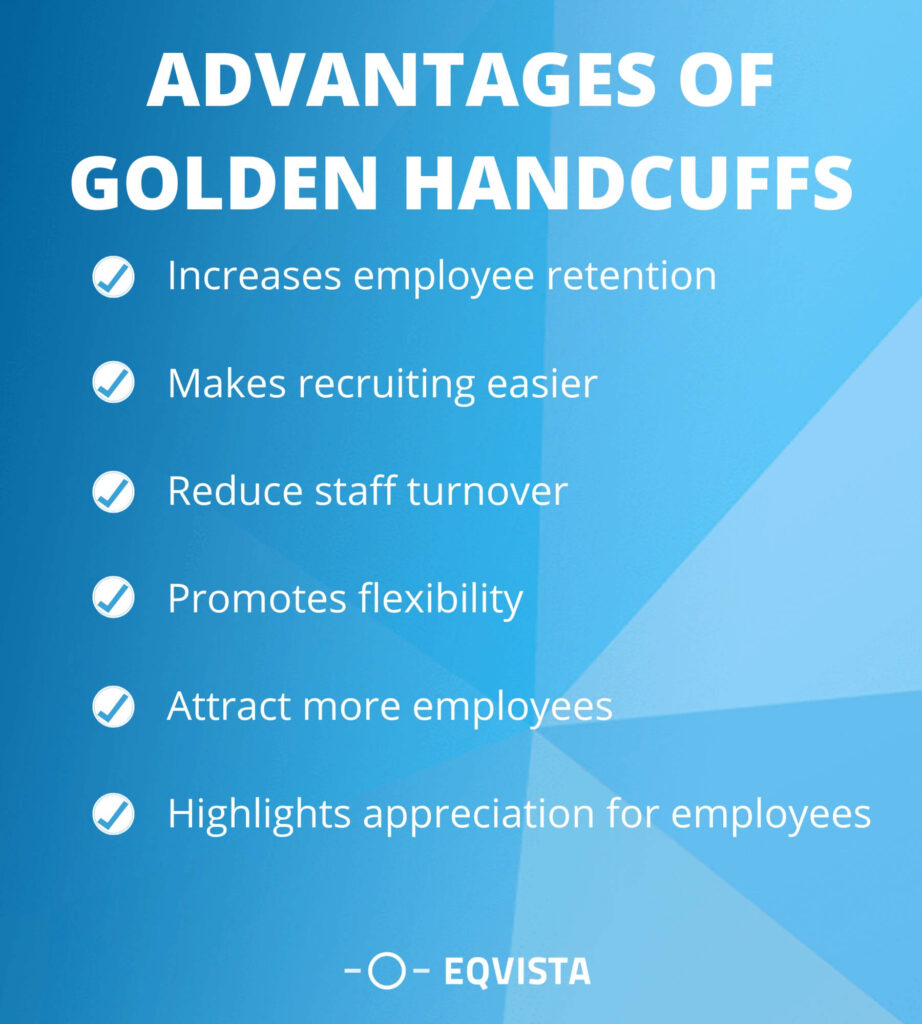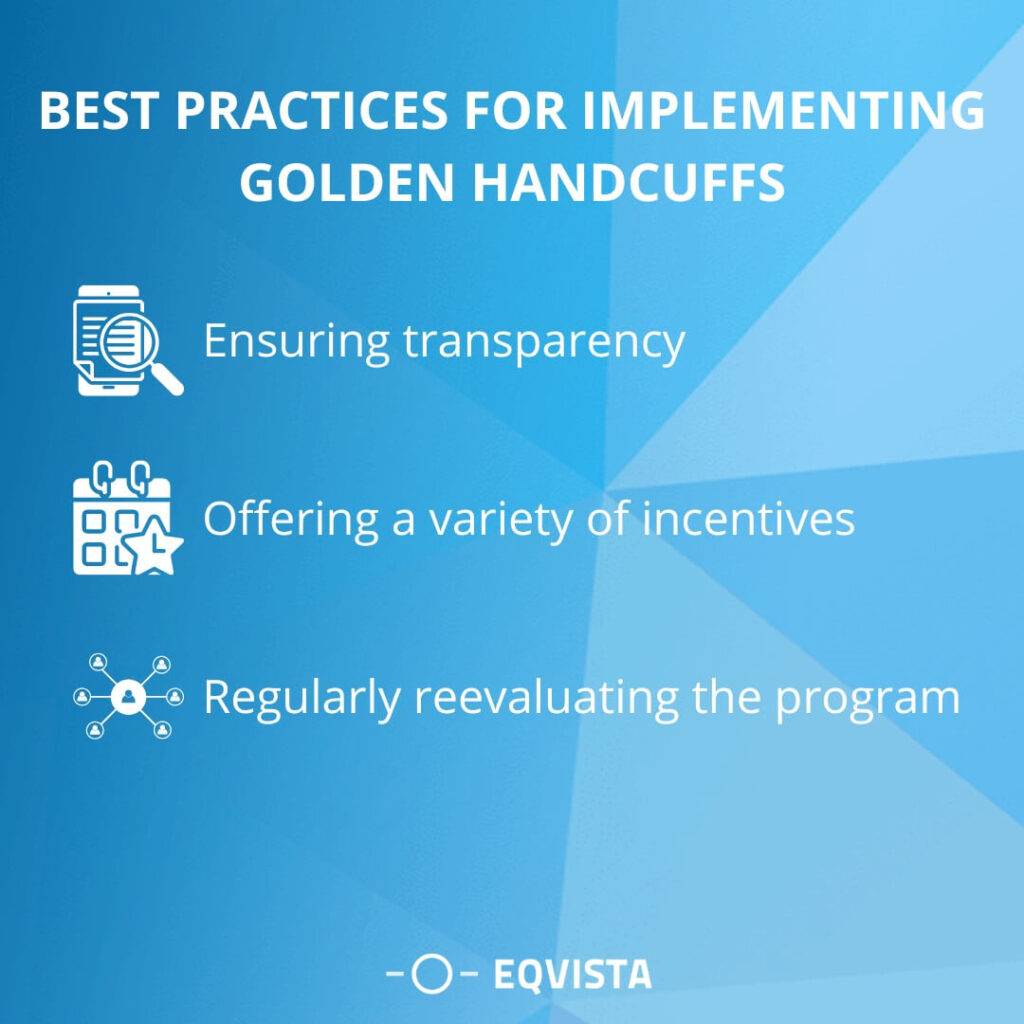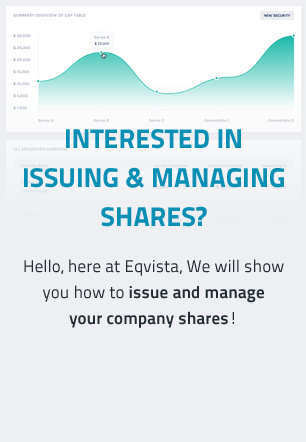Golden Handcuffs: Retention Strategy Pros and Cons
This article will guide you to the best practices for implementing golden handcuffs in your organization.
Employers utilize various methods, such as paid time off, overtime, and health insurance, to keep their workers around. Golden handcuffs are a common incentive for employees to remain with a business, mainly if the employees have been very productive. Learning about handcuff incentives and how they work might help you get a job with better compensation. There are a few types of golden handcuffs that organizations can use as their retention strategy. If you are an employer, you wouldn’t want to miss out on the advantages of golden handcuffs. And this article will guide you to the best practices for implementing golden handcuffs in your organization.
Golden handcuffs and retention strategy
When it comes to recruiting and retaining top talent, an incentive plan provides benefits that rivals will have a hard time matching. Executive pay plans that include insurance coverage are still the preferred incentive strategy for workers and firms due to the tax benefits and institutional pricing they provide. Because of this, companies may reward their most dedicated workers with permanent life insurance. This handcuff plan may only apply to permanent or highly valued employees. Let’s understand golden handcuffs in detail.
What are Golden Handcuffs?
The term “golden handcuffs” refers to a package of financial benefits offered to workers who commit to staying with the firm for a certain length of time. Employers use golden handcuffs to keep their most valuable workers from leaving and to encourage greater employee loyalty. This retention strategy is widespread in fields where highly rewarded workers often switch employers. Employees who are highly paid have exceptional performance, or possess unique abilities are the usual recipients of such bonuses.
Organizations may provide a variety of monetary incentives to attract and retain talented workers. Stock options, vacation houses, bonuses, use of a corporate automobile, and retirement plans are the most often offered incentives.
How do Golden Handcuffs work?
Executives who want to obtain a “golden handcuffs” payout must remain in their positions for some time. For instance, a 5-year cliff waiting timeline for stock options encourages employees to remain with the company for a minimum of five years so that they may reap the rewards of completely vested options. Here is the vesting schedule that you have been looking for.
A second form allows executives to get a benefit but requires them to repay it if they leave the company before the perk’s expiration date. For instance, if a CEO is reimbursed for training costs and leaves before the contract ends, they will likely be required to repay the money.
Types of Golden Handcuffs
Workers often provide a certain number of years of expertise in exchange for monetary compensation. Stock options, for instance, may take many years before they finally settle. Any 5-year service incentive would need the same time commitment. A golden locked-in incentive might also take the form of a prize that the employee must pay back if they leave the company before a certain period has passed. Additional forms of handcuff incentives include the following:
- SERPs – Supplementary executive retirement plan (SERP) is one incentive utilized by businesses to retain their employees. If the person meets specific requirements while on the job, the company and the worker agree on a certain amount of supplemental retirement income. After retirement, the worker receives the program’s accrued money, which may be subject to taxation.
- Incentive – To keep their staff happy and in their job, businesses provide a variety of benefits. For example, a software engineer could care less about salary and more about having access to unlimited paid time off and a company computer. Lunch breaks that last longer, complimentary dinners, and gift cards are examples of smaller incentives.
- Stock options – Stock investment opportunities are a typical kind of incentivization for employees. Employees’ potential earnings on investments in company shares are very sensitive to the overall performance of the firm or industry in which it operates. Workers are boosted in their efforts and commitment to the company.
- Milestone – This entails rewarding workers for achieving milestones and accomplishing several tasks. For instance, a software company’s extensive benefits package may have attracted a new hire, including quarterly incentives, catered lunches, and a free gym membership. After six months, employees are entitled to these benefits, encouraging them to stay. In a similar vein, a company will only provide bonuses to long-term workers who have been with the company for at least a year.
Example of Golden Handcuffs
Software engineers often look for new jobs after attaining a prestigious certification that often leads to a better salary. Two of the companies caught their attention. The engineer at ABC Inc., for instance, receives a salary of £60,000 per year in addition to benefits including medical coverage, a retirement account, and overtime compensation. The second company, XYC Software, generates £40,000 annually, has the same benefits as ABC Inc, and offers a quarterly bonus reward of £6,000. The engineer might make more money working for ABC Inc. each year, but he chooses to work for XYZ Software because of the generous bonus structure.
Advantages of Golden Handcuffs
In certain fields or occupations, turnover is very expensive due to the high value and difficulty of replacing key employees. If the job market is competitive, this becomes much more significant. All these perks may appear pricey to a company, but it’s usually cheaper than losing a good worker. Additionally, handcuff incentives have the following advantages:

- Increases employee retention – Handcuff incentives are offered by companies to workers in the hopes that they would remain with the firm for longer periods. Managers often incentivize long-term employment by tying perks too meeting certain performance criteria.
- Makes recruiting easier – Employer handcuffs are a useful tool in the war for talent. Businesses benefit from golden incentives because they encourage top-tier candidates to consider working for the company in question.
- Reduce staff turnover – Employee turnover is quite expensive. A firm’s turnover may affect its running costs, profits, productivity, and even corporate culture. These restraints are crucial to keeping employees loyal to a corporation.
- Promotes flexibility– Golden incentive agreements, which might take the form of stock options, vacation homes, or corporate automobiles, provide firms with significant flexibility in terms of contracting creativity. The duration of an agreement is also a matter of company discretion.
- Attract more employees – These bonuses are meant to attract and retain the best personnel in the industry. If a company is looking to fill a senior job, it should offer a salary that is competitive with the market. Beyond money and the promise of a new job, an alluring handcuff program may be a crucial factor in persuading someone to make the change.
- Highlights appreciation for employees – Handcuff incentives are a way for businesses to demonstrate appreciation for their employees’ efforts. Employees are rewarded for going above and above the call of duty, which increases revenue and improves the business as a whole.
Disadvantages of Golden Handcuffs
Both companies and workers may have downsides when golden handcuffs are in place such as the following.
- When there are several sorts of incentives involved or various vesting timelines, golden handcuffs may be difficult and expensive to manage for businesses.
- Golden handcuffs may also lead to legal and financial complications, such as ERISA compliance, accounting requirements, or IRS rules.
- Furthermore, golden handcuffs may backfire if they make workers feel stuck or devalued by the firm, both of which can lead to increased levels of anger and discontent.
- Some workers may complain that they aren’t getting what they’re worth at work or that they’re being passed over for promotions.
Alternatives to Golden Handcuffs
A golden handcuffs approach isn’t the only method to keep excellent personnel around. There are a variety of additional things that businesses can do to create an atmosphere where workers like coming to work and are motivated to remain with the firm. For instance, offering professional growth and educational opportunities, cultivating an environment of confidence and cooperation that gives employees the freedom to make choices and exchange ideas, encouraging work-life harmony and adaptability, and requesting input from employees on the organization’s objectives, regulations, and protocols are all efficient approaches. Employers may guarantee that their workers are engaged and driven to remain with the firm by doing this.
When should you use Golden Handcuffs?
Employers should think carefully about the employee’s function and contribution to the organization, as well as the employee’s marketability and attractiveness, before resorting to golden handcuffs. They must also think about the costs and advantages of losing or keeping the employee, as well as the length and conditions of the contract of employment or agreement. Additionally, it is essential to evaluate whether or not the employee’s values and the company’s values are congruent and complementary.
How golden handcuffs are typically structured?
If companies want to keep their best staff around, they could consider offering golden handcuffs. There should be a balance between immediate and long-term incentives and threats, as well as specific and attainable criteria for measuring performance and determining when an employee’s deferred compensation becomes fully vested. In this way, the golden handcuffs will be more likely to keep valuable personnel from leaving.
Best Practices for Implementing Golden Handcuffs
Your company might benefit from a golden handcuff if it is having trouble attracting and maintaining top people. Let’s examine the details of developing a golden handcuffs plan.

- Ensuring transparency – Many business owners negotiate with employees while keeping their long-term goals for them a secret. Share your plans and discuss the future. It will demonstrate to them that they can have faith in you down the road. Instead of trying to get more out of them, your agency would be better off encouraging them to think long-term about what they can accomplish while working with you.
- Offering a variety of incentives – Compensation goes beyond only money. Employees are dedicated to their employers for a variety of reasons, including a satisfying work-life balance, a supportive management team, opportunities for advancement, a pleasant work environment, a good match with their personal beliefs, and so on. Therefore, your ultimate objective should be to make each employee feel useful, protected, and engaged so that they look forward to going to work each day.
- Regularly reevaluating the program – Companies may benefit by reevaluating their “golden cuffs” strategies by learning where they can make changes for the better, where they can save costs, and where they can take advantage of new possibilities. This may include tracking market trends, assessing data and analytics, keeping up with industry advances, and hearing from consumers, workers, and other stakeholders.
Manage your company’s ESOP on Eqvista!
Properly implemented, golden handcuffs may increase employee loyalty like nothing else. If stock options or other equity-based pay are part of the agreement, an efficient equity compensation software is recommended for keeping track of employees’ equity grants. We at Eqvista have the expertise to provide first-rate management of equity compensation plans. We can streamline every aspect of equity management, from tools and processes to regulatory compliance and reporting. If you need assistance with your company’s ESOP management, contact us now!
Interested in issuing & managing shares?
If you want to start issuing and managing shares, Try out our Eqvista App, it is free and all online!
